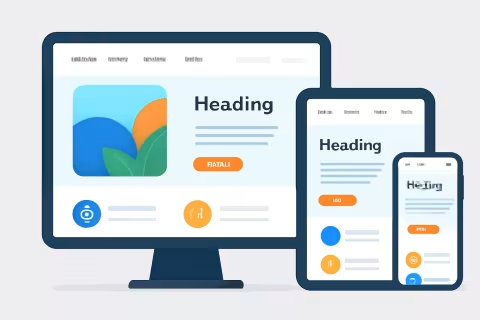Web design is the process of planning, conceptualising, and arranging content for online platforms. It goes far beyond creating visually attractive websites - web design encompasses usability, accessibility, responsive functionality, and the overall user journey, ensuring that visitors not only find information but also enjoy interacting with it. A well-designed website serves as a digital front door to an organisation, shaping first impressions and driving engagement.
Core Elements of Web Design
- Layout: The structure and organisation of content on a page. Effective layouts create a logical flow, helping users navigate intuitively, highlighting important information, and supporting the site’s goals.
- Colour Scheme: Strategic use of colour creates mood, evokes emotion, and assists with brand recognition. Colour choices must support readability, contrast, and accessibility.
- Typography: The style, arrangement, and appearance of text. Good typography improves readability and reinforces the desired tone - whether professional, playful, modern, or authoritative.
- Images & Graphics: Visuals, including photos, icons, and illustrations, make content more engaging and help communicate messages quickly and effectively.
- Navigation: Menus, links, and other navigational tools help visitors move effortlessly through the site. Clear, consistent navigation is essential for user retention and satisfaction.
- Responsiveness: With users accessing sites on a variety of devices, responsive web design ensures seamless experiences across desktops, tablets, and smartphones.
Principles of Modern Web Design
- User-Centred Design: Understand the target audience and build sites with their needs, behaviours, and preferences in mind.
- Accessibility: Ensure sites are usable for all users, regardless of physical or cognitive abilities, by following best practices such as using alt text, providing sufficient colour contrast, and implementing keyboard navigation.
- Performance Optimisation: Fast-loading pages and optimised media are crucial for retaining visitors and improving search rankings.
- Consistency: A uniform visual and functional language throughout the site fosters trust and enables users to quickly grasp site patterns.
- Visual Hierarchy: Design elements guide the user’s attention to the most important content and actions, making information easy to digest.
- Content Quality: High-quality, relevant, and well-written content keeps users engaged and improves SEO performance.
The Web Design Process
- Discovery & Research: Define goals, target audience, and key features. Analyse competitors and gather inspiration.
- Wireframing & Prototyping: Sketch page layouts and interactive prototypes to map user journeys and test ideas before full development.
- Visual Design: Develop the look and feel, from colour palettes to iconography and imagery.
- Development: Turn designs into functioning webpages using languages like HTML, CSS, JavaScript, and leveraging content management systems (CMS) like WordPress, Drupal, or custom frameworks.
- Testing & Optimisation: Ensure the site works flawlessly across different devices, browsers, and network conditions. Usability and accessibility are tested thoroughly.
- Launch & Maintenance: Deploy the site live and continuously update content, monitor performance, and implement improvements based on user feedback and analytics.
Why Web Design Matters
A great website is an indispensable business tool. It helps organisations:
- Establish credibility and trust
- Communicate their brand and values
- Attract and retain customers
- Increase conversions and achieve business objectives
- Provide vital information and customer support 24/7
Conclusion
Web design is not just about making sites look impressive; it’s about delivering purposeful, effective solutions that delight users and drive results. By combining creativity, technical skills, and a deep understanding of user needs, web design transforms online ideas into engaging digital experiences that leave a lasting impression.
Category
Pictures
- Image

